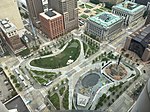Fountain of Eternal Life
1964 establishments in Ohio1964 sculpturesBronze sculptures in OhioBuildings and structures in ClevelandCulture of Cleveland ... and 10 more
Downtown ClevelandFountains in OhioMonuments and memorials in OhioNude sculptures in the United StatesPeace monuments and memorialsSculptures by Marshall FredericksSculptures of men in OhioStatues in OhioTourist attractions in ClevelandWar monuments and memorials

The Fountain of Eternal Life, also known as the War Memorial Fountain and Peace Arising from the Flames of War, is a statue and fountain in downtown Cleveland, Ohio designed by Cleveland Institute of Art graduate Marshall Fredericks and dedicated on May 30, 1964. The sculpture, which honors Greater Clevelanders who served, died, or were declared missing in military service, is situated on Veterans' Memorial Plaza (formerly Mall A) as part of the Cleveland Mall.
Excerpt from the Wikipedia article Fountain of Eternal Life (License: CC BY-SA 3.0, Authors, Images).Fountain of Eternal Life
Cleveland
Geographical coordinates (GPS) Address Nearby Places Show on map
Geographical coordinates (GPS)
| Latitude | Longitude |
|---|---|
| N 41.5017 ° | E -81.6929 ° |
Address
Cleveland
Ohio, United States
Open on Google Maps










